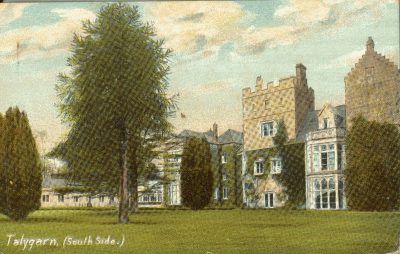Talygarn House

Talygarn lies in the rolling hills to the south of Pontyclun. It is an estate whose fortunes have ebbed and flowed over the centuries. Its origins can be traced to the twilight years of Welsh independence in the 14th century when it was held as a native lordship rather than falling under Norman control after the conquest.
While the early manor house has long since vanished, glimpses of Talygarn’s subsequent incarnations remain. The estate’s prominence grew under the tenure of Sir Leoline Jenkins in the 17th century. This erudite lawyer and diplomat was born near Talygarn in 1625. He also bequeathed funds to restore the ancient chapel-of-ease that had served the local community for generations.
The earliest record of a garden on the site is a tithe map of 1841. At this date, the site had plantations, orchards and a large meadow, and was in the ownership of Dr. William Lisle. He had bought the property in about 1817, but moved to St Fagan’s by 1851, at which point the gardens became rather neglected. On his death in 1856, the estate passed to his daughter, who sold it in 1865 to George Thomas Clark.
It was this acquisition that truly transformed the estate. An engineer and archeologist who had collaborated with Isambard Kingdom Brunel, Clark set about renovating what he described as the existing manor’s “queer, rambling” form. Over three decades, he oversaw a comprehensive remodeling that transported the architectural and decorative Arts of Renaissance Italy to this Welsh corner.
Picturesque grounds and Gardens were planted, containing beautiful flowering shrubs and a large lake bordered with Rhododendrons was created.The manor’s interiors were reborn with exquisite carved woodwork, Venetian painted ceilings, Verona marble fireplaces, Neapolitan tiles, and marquetry doors from Vicenza.
It was an opulent undertaking befitting Clark’s status – his wife Ann Price Lewis hailed from the founders of the mighty Dowlais Ironworks, which Clark helped steer to global prominence until his death in 1898. As such Talygarn became a symbol of Wales’s industrial might
Talygarn remained a familial estate after Clark’s passing, with his son Godfrey completing the renovations.
By the 1920s, its genteel days were numbered and it was sold in 1922 to The South Wales Miners’ Federation. In a twist of fate, this opulent residence transformed into a sanctuary for the very workers who fueled Wales’ industrial revolution. From 1923 Talygarn served as a convalescent home and rehabilitation centre, providing care and respite to generations of miners and their families.
During this time it was supported by Paul Robeson a famous American singer who not only contributed to its running costs, but performed for the miners who were here.
In 1951 after its use as a miners’ convalescent home, Talygarn passed to the National Health Service. It was sold to developers in 2001 for conversion into apartments.
More information on the gardens at Talygarn House can be found here